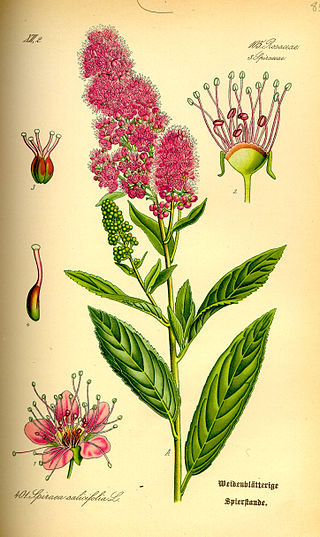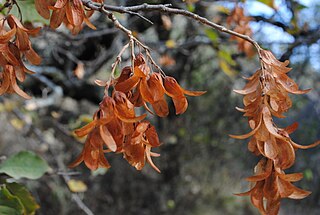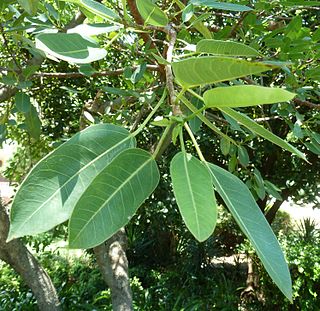
Spiraea, sometimes spelled spirea in common names, and commonly known as meadowsweets or steeplebushes, is a genus of about 80 to 100 species of shrubs in the family Rosaceae. They are native to the temperate Northern Hemisphere, with the greatest diversity in eastern Asia.

Heimia salicifolia is a species of flowering plant in the Loosestrife family, Lythraceae. It is native to the Americas, ranging from the southwestern United States through Mexico and Central America to Argentina. Common names include shrubby yellowcrest, sinicuichi, sun opener, willow-leaf heimia, sini. The plant has been used for shamanic purposes by native peoples in Central America and Mexico.

Hakea is a genus of about 150 species of plants in the Family Proteaceae, endemic to Australia. They are shrubs or small trees with leaves that are sometimes flat, otherwise circular in cross section in which case they are sometimes divided. The flowers are usually arranged in groups in leaf axils and resemble those of other genera, especially Grevillea. Hakeas have woody fruit which distinguishes them from grevilleas which have non-woody fruit which release the seeds as they mature. Hakeas are found in every state of Australia with the highest species diversity being found in the south west of Western Australia.

Magnolia salicifolia, also known as willow-leafed magnolia or anise magnolia, originates from Japan. It is a small deciduous tree 7.5 m (25 ft) tall, with narrow lanceolate leaves with whitened undersides. The leaves are not as narrow as true willows (Salix), but is narrow compared to other magnolias, giving this tree a finer texture. The 10 cm-wide scented flowers emerge in early spring before the leaves. The leaves and bark are fragrant when crushed.

Pyrus salicifolia is a species of pear, native to the Middle East. It is widely grown as an ornamental tree, almost always as a pendulous cultivar, and is called by various common names, including willow-leaved pear, weeping pear, and similar. The tree is deciduous and of comparatively small stature, rarely reaching 10–12 meters in height. The crown is rounded. It has pendulous, silvery foliage, superficially similar to a weeping willow. The flowers are large and pure white highlighted with black-tipped stamens although the buds are tipped with red. The small green fruits are inedible, being hard and astringent.

Hakea salicifolia commonly known as the willow-leaved hakea, is species of flowering plant that is endemic to eastern Australia. It is an adaptable, fast growing small tree or shrub with attractive foliage and cream white flowers.

Ruprechtia apetala is a species of deciduous tree in the family Polygonaceae. It is found in Argentina and Bolivia. It is threatened by habitat loss. In autumn, its leaves turn bright yellow and orange.

Tetrataxis is a genus of plant in family Lythraceae. The sole species is Tetrataxis salicifolia. It is endemic to Mauritius. Its natural habitat is subtropical or tropical dry forests.

Franz Josef Ruprecht was an Austrian-born physician and botanist active in the Russian Empire, where he was known as Frants Ivanovič Ruprekht.

Baccharis salicifolia is a blooming shrub native to the sage scrub community and desert southwest of the United States and northern Mexico, as well as parts of South America. Its usual common name is mule fat; it is also called seepwillow or water-wally. This is a large bush with sticky foliage which bears plentiful small, fuzzy, pink or red-tinged white flowers which are highly attractive to butterflies. The long pointed leaves may be toothed and contain three lengthwise veins. It is most common near water sources.

MagoniaA.St.-Hil. is a plant genus in the family Sapindaceae, with a single currently accepted species, Magonia pubescens, a tropical tree native to South America. MagoniaVell. is a synonym of Ruprechtia, a genus in the family Polygonaceae.

Veronica stricta, synonym Hebe stricta, commonly called koromiko, is a flowering plant in the family Plantaginaceae, which is endemic to New Zealand.
G. salicifolia may refer to:
H. salicifolia may refer to:
M. salicifolia may refer to:
Salicifolia, a Latin word meaning willow-leaved, may refer to:

Veronica salicifolia, synonym Hebe salicifolia, the koromiko, or willow-leaf hebe, is a flowering plant in the family Plantaginaceae, which is found throughout the South Island of New Zealand and in Chile. It is a large, evergreen shrub, reaching 2 m in height, with light-green, spear-shaped leaves that are up to 12 cm long, and white or pale lilac flowers.

The Wonderboom is an evergreen fig species that ranges from the KwaZulu-Natal midlands northwards to tropical East Africa. It grows especially on outcrops, rocky hillsides and along cliffs fringing water courses and may rarely grow up to 10 m tall, and acquire a leafy spreading crown.

Quercus salicifolia is a species of oak. It is native to central and southern Mexico and Central America, from Jalisco to Panama.
Cordia salicifolia, also called Cordia ecalyculata and chá de bugre, is a species of evergreen flowering tree in the borage family, Boraginaceae, that occurs mainly in Brazil and is used as a medicinal plant. Its red fruit, which resembles a coffee bean and contains caffeine, is roasted and brewed as a coffee substitute.















